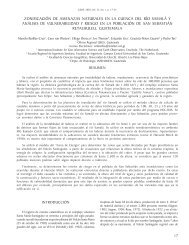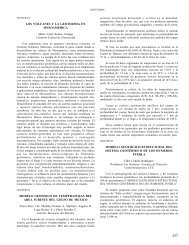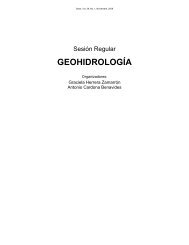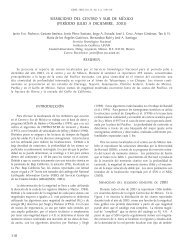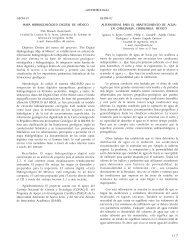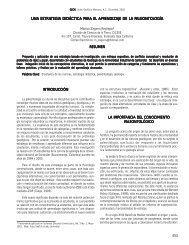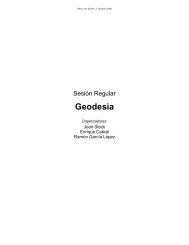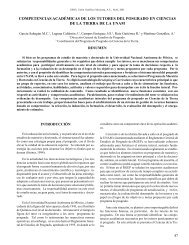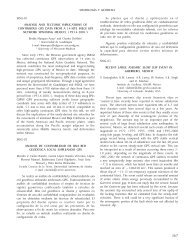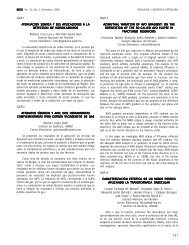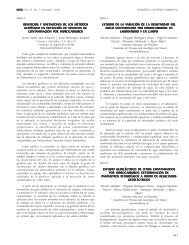Libro de resúmenes - Unión Geofisica Mexicana AC
Libro de resúmenes - Unión Geofisica Mexicana AC
Libro de resúmenes - Unión Geofisica Mexicana AC
You also want an ePaper? Increase the reach of your titles
YUMPU automatically turns print PDFs into web optimized ePapers that Google loves.
Geos, Vol. 31, No. 1, Noviembre, 2011G-GAP (THE GUERRERO SEISMIC GAP): NEW INSIGHTS OF THE SEISMICCYCLE, EPISODIC ASEISMIC SLOW SLIPS AND NONVOLCANIC...We present NVT relocations obtained with a new and promising technique(Cruz-Atienza et al., in preparation, 2011). This technique is based on NVTenergy-like and waveform correlation measurements in the three ground motioncomponents. By superimposing the hypocentral relocations over the evolvingPp lithospheric cross-section, a surprisingly good correlation appears betweenthe slab ‘attraction’ poles and a north-south NVT spatial segmentation, alsoreported in previous location catalogs. Both the secular and triggered NVTactivity during the SSE are localized over wi<strong>de</strong>spread regions of the middlecrust (~20 km <strong>de</strong>pth), clearly above the plate interface (~40 km <strong>de</strong>pth). Thefluid ‘attraction’ poles are generated by stress concentrations associated with theSSE northernmost slip edge and the kink of the slipping interface where the slabbecomes horizontal. Both stress concentrations induce important stain gradientsalong the slab top layer, which may open hydraulic windows allowing fluids torise into the overriding plate. The transient velocity change observed during the2006 SSE (Rivet et al., GRL, 2011) is a strong evi<strong>de</strong>nce of non-linear processesoccurring in the middle crust, which imply a transient reduction of the bulk shearmodulus (i.e. material strength) (Johnson and Jia, Nature, 2005). Such behavior,which is enhanced for low effective pressures (Pe) (i.e. where fluids are present),promotes shear failure and starts happening from <strong>de</strong>formation thresholds ofabout 10-6 that we show were clearly overcome during the 2006 SSE in the NVTlocus above the plate interface.SE11-7LOCALIZ<strong>AC</strong>IÓN DE TREMORES NO VOLCÁNICOSReal Pérez Jorge Arturo 1 , Kostoglodov Vladimir 1 y Payero De Jesús Juan Silvestre 21 Instituto <strong>de</strong> Geofísica, UNAM2 Instituto <strong>de</strong> Geofísica/Posgrado Ciencias <strong>de</strong> la Tierra, UNAMjorge8428@gmail.comLos Tremores No Volcá¡nicos (NVT) son episodios <strong>de</strong> actividad sí-smicarelativamente profunda (~20-40 km) con las frecuencias <strong>de</strong> entre 0.5 y 15 Hz,asociada generalmente a las zonas <strong>de</strong> subducción. La mayor actividad <strong>de</strong> NVTocurre sobre el área <strong>de</strong> transición entre el segmento <strong>de</strong> contacto interplacasismogénico y el segmento poco acoplado y mas profundo. La dificultad <strong>de</strong>localización <strong>de</strong>l NVT proviene <strong>de</strong> la ausencia <strong>de</strong> las fases emergentes clarasen los registros símicos correspondientes al tremor que pue<strong>de</strong>n duras <strong>de</strong>unos minutos y hasta horas. Algunos mo<strong>de</strong>los proponen que los NVT estánrelacionados al metamorfismo a bajas temperaturas en las zonas <strong>de</strong> subduccióny a la migración <strong>de</strong> fluidos <strong>de</strong>ntro <strong>de</strong> la micro-porosidad que presentan las rocasen la zona <strong>de</strong> transición (e.g., Obara 2002). Los NVT en muchos casos estánacompañando a los eventos asísmicos lentos (SSE).El estudio <strong>de</strong> estos fenómenos es el objetivo principal <strong>de</strong>l proyecto G-GAP, paralo cual se instalaron una red <strong>de</strong> mini-arreglos sí-smicos en el estado <strong>de</strong> Guerreoy Morelos, la mayorí-a <strong>de</strong> los sismómetros están distribuidos en una franja queva <strong>de</strong> Teloloapan Gro. al NW, hasta el pueblo Atenango <strong>de</strong>l Río Gro. al SE <strong>de</strong>lestado, tratando <strong>de</strong> tener una buena cobertura azimutal para po<strong>de</strong>r <strong>de</strong>terminar<strong>de</strong> una manera más exacta la localización y profundidad <strong>de</strong> este tipo <strong>de</strong> eventos.Dado que el rango <strong>de</strong> frecuencias en las que los NVT se manifiesta con laamplitud dominante es entre 1 a 10 Hz, es muy difícil po<strong>de</strong>r <strong>de</strong>finir un tiempo <strong>de</strong>inicio para estos eventos, ya que en este rango <strong>de</strong> frecuencias generalmente haymucho ruido sí-smico (ruido cultural y ruido meteorológico <strong>de</strong> periodo corto) porlo que hay que hacer filtrado <strong>de</strong> las señales para po<strong>de</strong>r mas o menos distinguirel inicio o final <strong>de</strong> NVT.El objetivo <strong>de</strong> este trabajo es comparar dos métodos <strong>de</strong> localización <strong>de</strong> NVT:el primero es por el análisis <strong>de</strong> la función <strong>de</strong> correlación <strong>de</strong> los envolventesentre registros en diferentes estaciones, y el segundo es usando la ventajaque proporcionan los mini-arreglos en registros <strong>de</strong> cuales es posible <strong>de</strong>terminarlas fases comunes entre las estaciones. La comparación <strong>de</strong> las localizacioneshechas por diferentes métodos muestra que aplicación <strong>de</strong> mini-arreglos tienemejor resultado.SE11-8INDUCCIÓN TELESÍSMICA DEL TREMOR NO VOLCÁNICO(NVT) EN LA ZONA DE SUBDUCCIÓN DE GUERRERO, MÉXICOPayero De Jesús Juan Silvestre 1 , Kostoglodov Vladimir 2 , HuskerAllen 2 , Shapiro Nikolai 3 , Campillo Michel 4 , Cotte Nathalie 4 ,Zigone Dimitri 4 , Real Pérez Jorge Arturo 1 y Cougoulat Glenn 41 Instituto <strong>de</strong> Geofísica/Posgrado Ciencias <strong>de</strong> la Tierra, UNAMvarias horas. Los NVT tectónicos o “ambientales” ocurren normalmente sinalguna clara relación con los terremotos o eventos asísmicos lentos (SSE).Mientras los SSE <strong>de</strong> gran<strong>de</strong>s magnitu<strong>de</strong>s registrados con GPS en Guerreroexcitan notablemente la actividad <strong>de</strong> SSE. Durante el funcionamiento <strong>de</strong> la redsísmica <strong>de</strong> los mini-arreglos, <strong>de</strong>l proyecto G-GAP, han ocurrido más <strong>de</strong> uncentenar <strong>de</strong> eventos telesísmicos (y regionales) importantes. Varios <strong>de</strong> ellos <strong>de</strong>magnitud Mw => 7.0, y otros <strong>de</strong> magnitud inferior, pero <strong>de</strong> buen interés por losefectos <strong>de</strong> excitación <strong>de</strong> NVT en México.Después <strong>de</strong> la ocurrencia <strong>de</strong>l gran sismo <strong>de</strong> Chile (2010) se <strong>de</strong>tectó unfuerte disparo <strong>de</strong> actividad <strong>de</strong> NVT en Guerrero, lo cual permitió revisarminuciosamente las características <strong>de</strong> los tremores <strong>de</strong> la región disparados porotros sismos. Este efecto conocido para algunas otras regiones <strong>de</strong>l mundo comoNVT inducido, complementa los estudios <strong>de</strong> NVT para la zona <strong>de</strong> Guerrero.Luego <strong>de</strong> analizar nueve terremotos <strong>de</strong> alta magnitud (telesismos y regionales)hemos encontrado que la inci<strong>de</strong>ncia <strong>de</strong> las ondas superficiales con un BAzentre (95º - 260º) respecto a la estación PLIG y otras estaciones <strong>de</strong> la red<strong>de</strong> mini-arreglos G-GAP, es probablemente un factor dominante para inducirla actividad <strong>de</strong> NVT. A parte <strong>de</strong> la relación observada anteriormente entre lostremores no-volcánicos ambientales y los eventos sísmicos lentos, este estudioha remarcado por primera vez la excitación <strong>de</strong> NVT por ondas superficiales enMéxico.SE11-9TRIGGERING OF TREMORS AND SLOW SLIP EVENT IN GUERRERO(MEXICO) BY THE 2010 MW 8.8 MAULE, CHILE, EARTHQUAKEZigone Dimitri 1 , Rivet Diane 1 , Radiguet Mathil<strong>de</strong> 1 , Campillo Michel 1 , Voisin Christophe 1 ,Cotte Nathalie 1 , Walpersdorf Andrea 1 , Shapiro Nikolai 2 , Cougoulat Glenn 1 , RouxPhilippe 1 , Kostoglodov Vladimir 3 , Husker Allen 3 y Payero De Jesús Juan Silvestre 41 Institut <strong>de</strong>s Sciences <strong>de</strong> la Terre, UJF, France2 Institut <strong>de</strong> Physique du Globe <strong>de</strong> Paris, France3 Instituto <strong>de</strong> Geofísica, UNAM4 Instituto <strong>de</strong> Geofísica/Posgrado Ciencias <strong>de</strong> la Tierra, UNAMdimitri.zigone@obs.ujf-grenoble.frIn this study we investigate the triggering of seismic tremors and slip events inGuerrero (Mexico) by the great 2010 Maule earthquake (Mw 8.8) that occurredon February 27. We use data from the seismic mini-array of the French-MexicanG-GAP project, broadband data from the Servicio Sismologico Nacional ofMexico (SSN) and very broadband data from the GEOSCOPE UNM station inMexico City. To study the slow slip events, we used 5 GPS stations located inGuerrero along a profile from Mexico City to Acapulco.Our analysis of GPS time series shows that the 2010 Mw 8.8 Maule earthquakehas possibly triggered the second subevent of the 2009-2010 SSE in Guerrero(see Walpersdorf et al, 2011 for a <strong>de</strong>scription of the double SSE in 2009-2010).This triggering of slow slip is accompanied by strong triggered seismic tremors.First, we observed triggered tremors occurring during the passing of S waves,Love waves and Rayleigh waves. The greatest amount of energy and durationaccompanies the long-period Rayleigh waves, with smaller bursts during theS and Love waves. For the Rayleigh wave triggered tremor we observed thedispersion of Rayleigh waves in the envelopes of triggered tremors, whichindicates a very strong modulation of the source by the passing surface wave.This correlation and modulation of tremor activity observed for the direct surfacewaves is clearly observed during a few tens of minutes and then is progressivelylost with time after few hours.At a longer time scale, we observe a temporal link between slow slip eventand tremors. A temporal comparison between the GPS time series and thetremor activities shows that tiny variations in the ground displacements duringthe triggered SSE seem to correlate with the tremor activities. Such a correlationmay indicates that NVT activities during the triggered SSE in spring 2010 arecontrolled by the stress perturbations produced by the variations in the sliphistory of the slow slip event.This study shows that large amplitu<strong>de</strong> long period waves produced by distantearthquakes can trigger slow slip and tremors in a mature subduction zone withan already perturbed medium like the Guerrero subduction zone in February2010. Two types of tremors emerged: (1) Those directly triggered by the passingwaves and (2) those triggered by the stress variations associated to the triggeredSSE. This variety of phenomena and their relationship indicates a key role of theaseismic creep in the evolution of the Mexican subduction zone in response toa large teleseimic earthquake.2 Instituto <strong>de</strong> Geofísica, UNAM3 Institut <strong>de</strong> Physique du Globe <strong>de</strong> Paris, France4 Institut <strong>de</strong>s Sciences <strong>de</strong> la Terre, UJF, Francepayero@ollin.igeofcu.unam.mxLa zona <strong>de</strong> subducción <strong>de</strong> Guerrero, sureste <strong>de</strong> México, ha sido i<strong>de</strong>ntificadacomo una zona <strong>de</strong> alta actividad <strong>de</strong> Tremores No-Volcánicos (NVT) (Payeroet al., 2008, Kostoglodov et al., 2010). Des<strong>de</strong> 2005 han sido i<strong>de</strong>ntificados yanalizados cientos <strong>de</strong> tremores, con una duración <strong>de</strong> algunos minutos hasta179



![Libro de resúmenes [revisión final, 172 páginas] - UGM](https://img.yumpu.com/51565067/1/190x245/libro-de-resamenes-revisian-final-172-paginas-ugm.jpg?quality=85)
